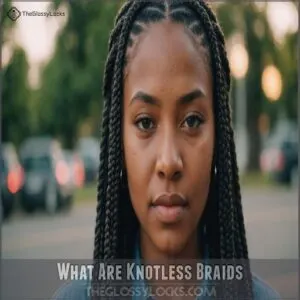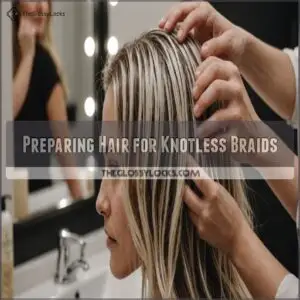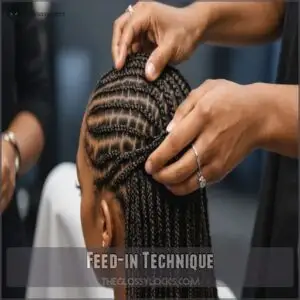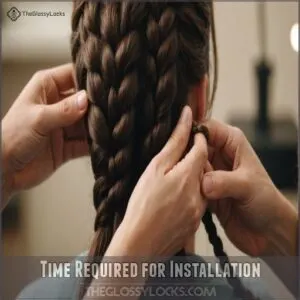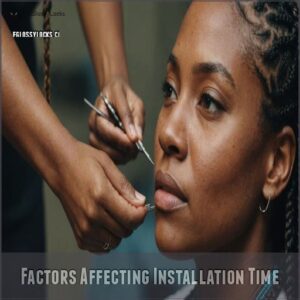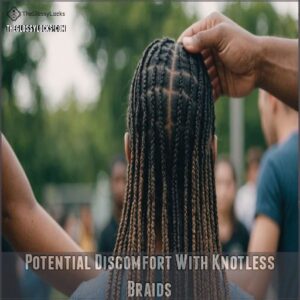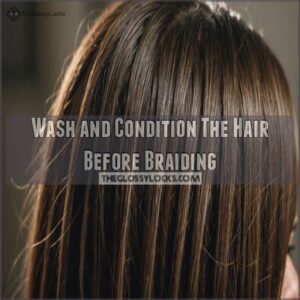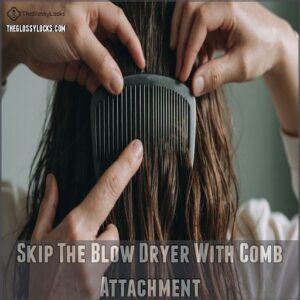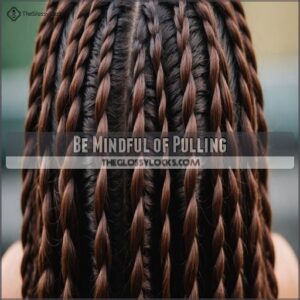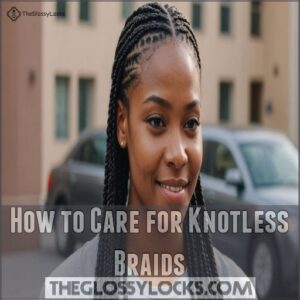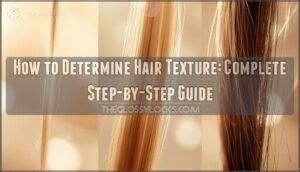This site is supported by our readers. We may earn a commission, at no cost to you, if you purchase through links.
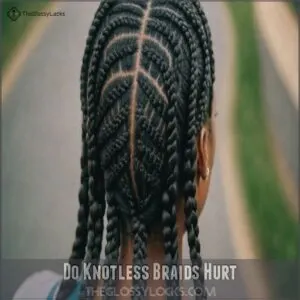
The secret lies in the technique—since they start with your natural hair and add extensions gradually, you avoid the intense pulling at the roots. This means less discomfort and less chance of those awkward post-braiding headaches.
Of course, everyone’s pain tolerance is different, and factors like the stylist’s technique can play a role. So, while knotless braids usually don’t hurt, it’s always wise to communicate with your stylist about any sensitivity.
Curious about keeping these beauties pain-free? More tips to follow!
Table Of Contents
- Key Takeaways
- What Are Knotless Braids
- Do Knotless Braids Hurt
- Preparing Hair for Knotless Braids
- The Installation Process of Knotless Braids
- Potential Discomfort With Knotless Braids
- Tips for Minimizing Pain With Knotless Braids
- How to Care for Knotless Braids
- Maintaining Knotless Braids for Long-Lasting Results
- Frequently Asked Questions (FAQs)
- Do braids have to hurt?
- What are the pros and cons of knotless braids?
- Are knotless box braids bad for your hair?
- Are knotless braids too tight or too heavy?
- How painful are knotless braids?
- Which braids are the least painful?
- What are the cons of knotless braids?
- Which braids last longer, knotless or regular?
- How long do knotless braids typically last?
- Can knotless braids be styled in different ways?
- Are knotless braids suitable for all hair types?
- What are the costs associated with knotless braids?
- How do knotless braids compare to traditional braids?
- Conclusion
Key Takeaways
- Knotless braids usually don’t hurt because they start with your natural hair, reducing intense pulling at the roots and minimizing scalp tension.
- Communicate your sensitivity level with the stylist to ensure they use a gentle technique, helping prevent any discomfort.
- Proper hair preparation and care can make the braiding experience more comfortable and prolong the style’s longevity.
- Knotless braids are lightweight, minimizing pain and allowing versatile styling without the stiffness of traditional braids.
What Are Knotless Braids
You’ll find that when transitioning to natural hair, incorporating deep conditioning treatments for moisture retention can be beneficial in reducing breakage and promoting healthy hair growth. Knotless braids are a protective hairstyle that uses a feed-in technique to gradually incorporate hair extensions into your natural hair without creating tension at the scalp.
Knotless braids, unlike traditional box braids that start with a knot, give you a lighter, more natural-looking result that’s gentler on your hairline.
Definition of Knotless Braids
Unlike traditional box braids that start with a tight knot at the base, knotless braids use a special feed-in technique that gradually incorporates hair extensions into your natural hair.
Think of them as the gentle giants of protective styles, offering both beauty and comfort.
This technique reduces the risk of traction alopecia from tight braids, making them a great option for those with hair growth concerns.
Here’s what makes them unique:
- No bulky knots at the scalp
- Extensions are woven in gradually
- Creates a more natural-looking change
These innovative braids distribute tension evenly across your scalp, making them a game-changer for anyone who’s ever winced through a braiding session.
History of Knotless Braids
The roots of knotless braids trace back to traditional African hairstyling methods, but they’ve evolved into a modern protective style that’s taken the hair world by storm.
Many popular products, including those found at knotless braid products, have contributed to their widespread adoption.
You’ll find their popularity has skyrocketed since 2019, as more people seek gentler alternatives to traditional box braids.
| Timeline | Milestone |
|---|---|
| Pre-2019 | Limited awareness of knotless technique |
| 2019-2021 | Social media boom and stylist adoption |
| 2022-Present | Industry standard for protective styling |
Benefits of Knotless Braids
Knotless braids pack a punch in terms of protecting your hair while looking fabulous. You’ll love these game-changing benefits:
- Zero scalp tension means better hair growth and happier edges
- Freedom to style your hair right after installation – no stiffness or discomfort
- Lightweight design lets you rock top knots and ponytails with ease
- Natural-looking results that blend seamlessly with your own hair
Plus, you’ll enjoy easier access to your scalp for moisturizing and maintenance, making these braids a win-win for both style and hair health.
Do Knotless Braids Hurt
When it comes to pain, you’ll be glad to hear that knotless braids are typically gentler on your scalp than traditional box braids. Think of them as your hair’s cozy sweater rather than a tight corset. While you might feel some initial tenderness during installation, it’s usually mild and temporary. If you’re looking for ways to alleviate any discomfort, consider checking out products specifically designed for knotless braid pain relief.
Here’s the real deal: the feed-in technique used in knotless braiding distributes weight more evenly across your scalp, greatly reducing tension headaches and that uncomfortable pulling sensation. You shouldn’t experience sharp pain or intense discomfort – if you do, speak up to your stylist immediately.
Most clients report feeling a slight tugging sensation during installation, but nothing that keeps them from scrolling through their phone or catching up on their favorite show. After the first day or two, any minor soreness typically fades completely, leaving you with a comfortable, protective style that won’t have you reaching for the painkillers.
Preparing Hair for Knotless Braids
You’ll want to start with freshly cleansed and deep-conditioned hair to make sure your knotless braids turn out their best.
Before your appointment, treat your hair with moisturizing products like shea butter or avocado-based conditioners to create the perfect foundation for this protective style.
Importance of Hair Preparation
Proper hair preparation is your secret weapon for a pain-free braiding experience. Before you jump into your knotless braid journey, getting your hair and scalp in top shape isn’t just a suggestion – it’s your ticket to comfort and lasting results. By following a hair care regimen that focuses on minimizing breakage and reducing manipulation, you’ll set yourself up for success.
Here’s what great preparation does for you:
- Strengthens your hair to handle the braiding process
- Reduces scalp sensitivity during installation
- Prevents unnecessary tension and breakage
- Makes the braids last longer while protecting your edges
Picture it like prepping a canvas before creating art – the better your foundation, the more beautiful and comfortable your final style will be.
Recommended Hair Care Products
Getting your hair care arsenal ready will make or break your knotless braids experience.
You’ll want to stock up on moisturizing shampoos, lightweight leave-in conditioners, and nourishing hair oils like argan or jojoba.
A quality scalp treatment can help reduce tension during installation, while styling products with hold (but not too much!) will keep your braids looking fresh longer.
Skip heavy butters that could weigh down your style.
Deep Conditioning for Hair Growth
Deep conditioning isn’t just a luxury—it’s your secret weapon for healthy hair growth before knotless braids. Think of it as giving your strands a power-packed smoothie of nutrients. You’ll want to deep condition 1-2 weeks before your appointment.
- Mix shea butter, avocado oil, and aloe vera for a DIY growth treatment
- Steam your hair for maximum nutrient absorption
- Leave the conditioner on for 30-45 minutes
- Use a heat cap to boost penetration
- Focus extra attention on your edges and ends
The Installation Process of Knotless Braids
You’ll notice your stylist using a unique feed-in technique that gradually incorporates hair extensions into your natural hair without creating tension at the roots.
While the installation process can take up to nine hours depending on your desired length and thickness, this careful approach guarantees your knotless braids will feel lightweight and comfortable from day one.
Feed-in Technique
The feed-in technique used for knotless braids is like building a bridge – you start with your natural hair and gradually add extensions as you braid downward.
Unlike traditional box braids, where extensions are knotted at the root, this method creates a seamless blend from scalp to tip.
To achieve this look, especially for curly hair, you need to start by dividing curls into smaller sections for easier handling, as recommended when learning how to braid curly hair.
You’ll feel the difference as your stylist works in small sections, incorporating synthetic hair piece by piece for a natural-looking result.
Time Required for Installation
While your braider works their magic with the feed-in technique, you’ll want to settle in for a while.
Installing knotless braids typically takes between 4-9 hours, depending on your desired look.
Here’s what you’ll want to bring to keep yourself comfortable:
- A fully charged phone or tablet for entertainment
- Comfortable, loose-fitting clothes
- Snacks and water
- A small pillow or neck cushion
The time investment pays off – you’ll rock these protective styles for weeks to come.
Factors Affecting Installation Time
Several key factors will influence how long you’ll be in that stylist’s chair.
Your hair length, thickness, and chosen braid size play major roles – longer, thicker hair naturally takes more time to braid.
Your stylist’s experience level matters too, as seasoned pros work faster.
Plus, if you’re going for intricate styles like goddess braids or micro braids, you’ll need extra patience.
Potential Discomfort With Knotless Braids
While you’ll experience less tension with knotless braids compared to traditional box braids, you might still feel some discomfort if your stylist uses too many hair extensions or braids too tightly.
Communicating your sensitivity level with your stylist and ensuring they don’t overload your braids with extensions will help you find the most comfort.
Traction Alopecia Prevention
Properly installed knotless braids greatly reduce your risk of traction alopecia compared to traditional box braids.
By distributing tension evenly across your scalp, these protective styles help maintain scalp health and prevent hair breakage.
You’ll notice less tightness around your edges, where hair loss often begins.
Regular breaks between installations give your hairline time to recover, ensuring long-term protection of your natural hair.
Excessive Hair Extension Weight
Too much extension weight can turn your protective style into a painful experience.
Beyond discomfort, heavy braids create unwanted scalp tension that affects your daily activities.
Here’s what excessive weight can cause:
- Constant pulling sensation at your hairline
- Neck strain during sleep and movement
- Headaches that worsen throughout the day
You’re in control – opt for lighter extensions and shorter lengths to maintain both style and comfort.
Reducing Discomfort During Installation
You can greatly reduce discomfort during knotless braid installation by communicating openly with your braider about tension preferences.
Ask them to use a gentle braider technique and incorporate regular scalp massage breaks.
Proper hair sectioning and tension control make a world of difference.
Remember, everyone’s pain tolerance varies, so don’t hesitate to speak up if you need adjustments – your comfort matters.
Tips for Minimizing Pain With Knotless Braids
You don’t have to endure discomfort to rock those stunning knotless braids you’ve been dreaming about.
With the right preparation and attention to detail, you’ll discover simple yet effective ways to make your braiding experience as comfortable as that favorite worn-in t-shirt you can’t live without.
Wash and Condition The Hair Before Braiding
Clean, well-moisturized hair is your ticket to a pain-free braiding experience.
Start with a clarifying shampoo to remove buildup, then deep condition for at least 30 minutes.
Focus on your scalp and edges, where tension tends to build up.
Pro tip: Many experienced braiders recommend using products with shea butter or avocado oil for extra slip and protection during the installation process.
Skip The Blow Dryer With Comb Attachment
Blow drying with a comb attachment before braiding can lead to unnecessary heat damage and strain on your natural texture.
Instead, let your hair air dry or use a microfiber towel to remove excess moisture.
If you must use heat, opt for a handheld dryer on low heat without attachments, keeping it at least six inches from your scalp to protect your hair’s integrity and prevent breakage.
Be Mindful of Pulling
Excessive pulling during installation can lead to unnecessary scalp tension and discomfort.
Ask your braider to maintain gentle pressure throughout the process, especially around your edges and nape.
When you feel sharp tugging or intense pressure, speak up immediately – your comfort matters more than perfect-looking braids.
Remember, proper sectioning and gentle braiding techniques shouldn’t cause pain or headaches.
How to Care for Knotless Braids
You’ll need to keep your knotless braids clean and moisturized to maintain their fresh, sleek appearance for weeks to come.
With proper care, including regular scalp cleansing and the right leave-in conditioners, knowing your hair porosity is crucial for choosing the right products. You can extend the life of your protective style while keeping your natural hair healthy underneath.
Regular Scalp Cleansing
Your scalp deserves the same TLC as your face – maybe even more when you’re rocking knotless braids.
Regular cleansing keeps your protective style fresh and your scalp happy.
Here’s how to master your cleansing routine:
- Use a clarifying shampoo diluted with water in an applicator bottle
- Focus on massaging your scalp, not rubbing the braids
- Gently pat dry with a microfiber towel to prevent frizz
Moisturizing With Leave-in Conditioners
Keep those knotless braids looking fresh by applying leave-in conditioner every 2-3 days.
Light, water-based formulas work best – try products with natural oils like jojoba or argan.
Leave-in conditioners, which provide a welcome escape from the hassles of tangled, matted hair by deeply hydrating and strengthening hair over time (minimize breakage with leave-in conditioners), are perfect for this task.
Just mist the conditioner onto your braids and scalp, then gently work it in with your fingertips.
Don’t overdo it though – a little goes a long way in preventing dryness while keeping your braids neat and frizz-free.
Refreshing The Hair With Mousse and Blow-dryer
Once your leave-in conditioner has settled, applying mousse and using a blow-dryer can breathe new life into your knotless braids.
Start by working a golf ball-sized amount of mousse through your braids, focusing on areas that need extra definition.
With your blow-dryer on medium heat, gently work through sections to tame frizz and add volume.
This quick refresh can make your braids look freshly installed.
Maintaining Knotless Braids for Long-Lasting Results
You’ll get the most out of your knotless braids by following a few essential maintenance steps, including regular touch-ups and proper protection during sleep and exercise.
Knotless braids are low-maintenance, but you’ll need to refresh them after water exposure.
You should also schedule stylist appointments every two weeks to keep them looking fresh and neat.
Booking Retouch With a Stylist
Booking a retouch with your stylist is a savvy move to keep your knotless braids fresh and fabulous.
This little upkeep trick guarantees they’re always in tip-top shape, minimizing frizz and preserving style longevity.
Weigh the stylist recommendations, cost comparison, and retouch frequency to decide.
Don’t forget to check stylist availability, making sure your preferred time slot is available!
Protecting Braids During Sleep and Physical Activity
To keep your knotless braids looking fresh, protect them during sleep and exercise.
A simple nighttime routine with a satin bonnet, like those available at Satin Bonnet Shop, locks in moisture and prevents frizz.
For active styles, secure your braids in a loose bun or large braid.
Don’t spoil that sleek look during workouts—opt for protective hair care to maintain those fabulous braids.
Refreshing Braids After Water Exposure
Your braid care routine is important, especially after a splash.
Moisturizing braids post-shower is like giving them a tall drink of water.
Use a leave-in conditioner to lock in moisture and prevent frizz.
For a nice touch, apply mousse, then blow-dry gently on low heat.
This simple routine can revive your style, leaving you ready for anything.
Frequently Asked Questions (FAQs)
Do braids have to hurt?
Braids don’t have to hurt; they should fit like a gentle hug for your hair.
A skilled stylist uses techniques that reduce tension and discomfort, ensuring you enjoy your style without unnecessary pain or scalp stress.
What are the pros and cons of knotless braids?
Knotless braids offer a gentler, lightweight feel, minimizing scalp tension. However, they’re time-consuming and pricey. Weigh the pros and cons; it’s a big commitment!
Are knotless box braids bad for your hair?
Joking aside, knotless box braids are typically gentle on your hair, reducing tension and breakage risk.
Their lightweight nature preserves your natural hair health, but excessive extensions might still cause some strain if not managed carefully.
Are knotless braids too tight or too heavy?
You won’t find knotless braids too tight or too heavy.
They use a feed-in method that reduces tension on your scalp, offering comfort and a lightweight feel.
However, too many extensions might still add some weight.
How painful are knotless braids?
Getting knotless braids typically involves minimal discomfort compared to traditional braids.
Since the tension is reduced without a starting knot, you’re less likely to experience pain, making them a more comfortable option for protective styling.
Which braids are the least painful?
Knotless braids are among the least painful braid options.
They distribute tension evenly across your scalp, offering a gentler feel compared to traditional braids.
With their lightweight design, they reduce stress and potential discomfort considerably.
What are the cons of knotless braids?
They’re pricier and take longer to install than traditional braids. Also, while gentler, too many extensions can still weigh down your scalp. Proper maintenance is key!
Which braids last longer, knotless or regular?
Imagine your braids as a vibrant tapestry on your head.
Knotless braids last longer due to their gentle technique, reducing scalp tension.
Regular box braids might feel taut, but often need quicker refreshes and maintenance.
How long do knotless braids typically last?
Typically, knotless braids last longer than box braids, with a lifespan of 6-8 weeks.
This lifespan depends on your hair type, lifestyle, and maintenance routine.
This allows you to enjoy a low-maintenance hairstyle for several weeks.
Can knotless braids be styled in different ways?
A whopping 95% of people say knotless braids let their creativity flow.
You can style them in buns, ponytails, or Bohemian waves without stiffness.
This versatility gives you the power to express your unique style effortlessly.
Are knotless braids suitable for all hair types?
Knotless braids suit all hair types, offering versatility and comfort.
They work well with thick, thin, wavy, or straight hair, minimizing breakage and promoting healthy hair.
Tailor the style to your hair’s length and texture for the best results.
What are the costs associated with knotless braids?
Costs vary widely, depending on your stylist’s location and experience, plus the length and type of hair used. Expect to pay anywhere from $300 to $
How do knotless braids compare to traditional braids?
Traditional braids often cause scalp tension with their signature knots, while knotless braids skip this step, offering a gentler feel.
You’ll enjoy a flexible, natural look without sacrificing comfort, though knotless styles require more time and investment.
Conclusion
Ultimately, deciding if knotless braids hurt hinges on personal experience.
Knotless braid styles prioritize comfort by reducing tension on your scalp.
Like a gentle embrace compared to traditional braids, by preparing your hair properly, communicating openly with your stylist, and carefully maintaining the braids, you can likely avoid discomfort altogether.
Whether it’s less pain or a stylish look you’re after, knotless braids might just be the perfect fit for keeping both your beauty and ease in balance.

